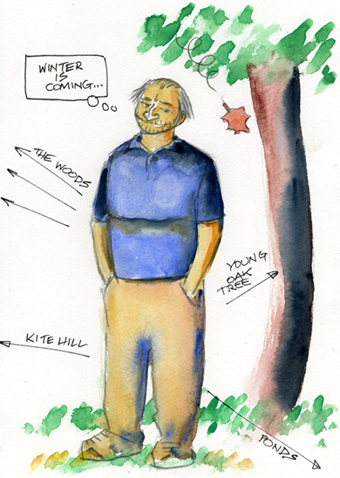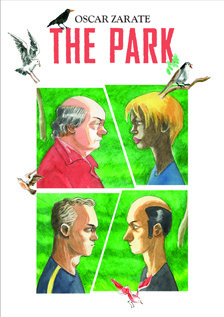Oscar Zarate’s urban oasis
by Mark Reynolds
Self-portrait on Hampstead Heath by Oscar Zarate
The tranquillity of a glorious early summer day on Hampstead Heath is interrupted when an angry blogger and a timid musician get embroiled in a tit-for-tat spat that threatens to escalate into a fractious but comical revenge drama worthy of Laurel and Hardy. So begins Oscar Zarate’s beautifully drawn graphic novel The Park, which charts how urban dwellers interact with the natural world and with each other – while nature itself carries on regardless.
You clearly have a strong affinity with Hampstead Heath. Do you live close by? And how much time in a given week, month, or year do you spend there?
The Heath is a ten-minute fast walk from my flat, you could say the Heath is almost my back garden. I visit the Heath on average four or five times a week, with friends, and sometimes walking along by myself. I try to avoid Saturdays and Sundays, full of people like Oxford Street on a weekday.
At what time is Hampstead Heath at its best?
The Heath is at its most beautiful any time of day, any week, any month, any season. It is always full of splendour. It is about whether one is available or in a condition to be receptive to this world of beauty, this place of the imagination.
The natural world is acutely observed in this book. How much of the story also comes from human behaviour you have witnessed-whether on the Heath or elsewhere?
Stories and the creation of characters come from different sources, memories which live inside your private museum, things dancing in the air, things you find in dustbins, fragments of conversations you heard or thought you’d heard. One of the seeds of The Park is something I witnessed on the actual Heath. A man was having an argument with somebody else, not shouting but talking quite loud. If you had heard this same argument in a city street you wouldn’t have thought twice about it, but in this space, surrounded by birds, animals and very ancient trees, somehow it felt incredibly aggressive, an affront to the people walking by and to nature. If you are in a church you don’t talk loud, you whisper.
Have you encountered a comparable place to Hampstead Heath in other cities around the world?
All city parks fulfil a human need, they are common spaces and many are very beautiful but for me the Heath is something else: the possibility of getting lost in the woods, connecting oneself with the past at least for a couple of minutes, a place of wonder in an urban situation.
How long have you lived in the UK/London and which other areas do you frequently visit or you have called home?
I arrived in London in 1971. Since then I’ve always lived in London and I always will. I have another favourite walk which is along the Thames by the South Bank. At night with the lights coming from the buildings and bridges you feel as if you are walking into the most beautiful art installation.
How often do you travel to Argentina (or elsewhere)?
Lately my travels mostly have to do with my work, but I try to go to Buenos Aires when possible and when the winter is too severe here.
Which of the four main characters in The Park do you most closely identify with?
There’s a bit of myself in each of the characters, so in that sense the identification is very close indeed. But I like the young girl Mel very much. She’s brave, she makes things happen. She doesn’t hesitate, while I procrastinate.
Are you a regular reader of any blogs?
I’m gradually getting involved with the new universe of blogs. Feeling like a provincial boy approaching the big city for the first time. You bump into some terrific stuff which you wouldn’t see otherwise.
Are eco-activists like Mel fighting a losing battle?
I don’t think people go into a confrontation or a battle thinking they are going to lose. Some people in every generation are bound to try to remake the world, attempting to transform it or at least trying to stop the world from breaking down. The history of civilisation’s eternal struggle is the battle between people who are trying to build for humankind and the perverse, destructive mediocrity of people of unlimited greed.
Is it ever desirable or profitable to take revenge?
It depends on the circumstances. It may not be profitable or desirable, but in many cases it is a natural reaction to an act of aggression. It can be more healthy than turning the other cheek. However if you get involved in a tit-for-tat situation, at the same time you should be aware that you’re digging two graves – one for your enemy and the other for yourself.
What is the enduring appeal of Laurel and Hardy?
They are geniuses! And they are so funny. Their psychological complexity is very contemporary, their ambiguous relationship with bourgeois values, consuming goods, marriage, properties and the incapability of making it. They want to belong, but in the process of trying to make it, they destroy everything they aspire to. Laurel and Hardy do what we don’t dare to do. They act out everything they feel, they don’t repress anything and they always fail. In every film they fail better and they don’t care. If I was Minister of Education I would make Laurel and Hardy films a compulsory part of the curriculum.
You’re known for your collaborations with Alan Moore and Alexei Sayle. How did those projects come about?
I used to go to the Comedy Store in Soho, when Alexei Sayle was a compere there. He was so attuned to what England was going through at that time and he was very funny. I asked him if he was interested in collaborating with me on a graphic book about London and the result was Geoffrey and Tube Train and the Fat Comedian. If I remember well, I met Alan Moore in a bar. I told him I liked his work and he said he liked the book I did with Alexei. I’d had an idea floating around in my head for a while and I proposed it to him, he liked it. After that we met frequently both in London and in Northampton, we talked about all kinds of things, seemingly unrelated to the story. Somehow after all these meetings, around a year had passed by and the story had shaped itself. Then Alan wrote it and I drew it. The result was A Small Killing.
What are you working on next?
At present I’m working with the writer Richard Appignanesi on a graphic book called Hysteria, about Sigmund Freud’s first case. The pictures in this book are in black-and-white watercolour. I’m immensely enjoying working with a reduced palette. At the same time something is taking shape for a new graphic novel of mine, I can’t say much more at the moment, there are a lot of components floating around, waiting to start connecting with each other.
Oscar Zarate studied architecture and worked in advertising before leaving Argentina for London in his late twenties. His previous graphic novels include Geoffrey the Tube Train and the Fat Comedian with Alexei Sayle and A Small Killing with Alan Moore. He also edited the graphic collection of short stories It’s Dark in London (SelfMadeHero, 2012).
Mark Reynolds is a freelance editor and writer, and a founding editor of Bookanista.
The Park is published by SelfMadeHero. Read more.


